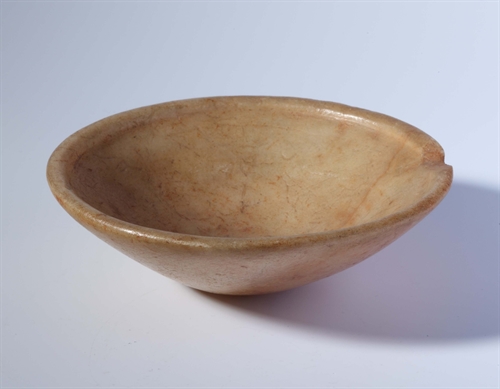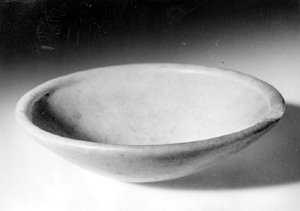Bowl

This alabaster (calcite) vessel is made like a typical pre-dynasty or early-bowl bowl. The weed edge spreads from top to bottom of the vessel. This type was commonly used in everyday life and was probably put into a tomb as a funeral equipment. It was probably found during some excavation on some pre-dynasty or early-cemetery graveyard. Similar bowls are often detected in the area of Abidos, Hierakonpola, Naqade, Tarkhan and Memphis during archaeological research at the end of the 19th and 20th centuries.
Comparative Material:
Very similar vessels are stored in the Oriental Institute Museum in Chicago (E11063, E7611), Rijksmuseum van Oudheden in Leiden (Inv. No. F1960 / 12.419b), niversity Colleage of London, Petrie Museum (from Tarkhana, inv. No. UC.16920, UC.14982, UC.35621); Metropolitan Museum of Art in New York (inv. No. 12.181.28, 12.181.38), Royal Museum of Mariemont in Mariemont (from Abidos, Inv. No. B.108), Musée du Louvre in Paris, Egyptian Museum in Cairo , The British Museum in London etc.
This subject has so far given up in the early Renaissance period. My latest research and comparative analysis of similar objects placed in numerous world museums has changed my previous thinking about data. Although it is difficult to put the subject in the exact time of its creation with certainty, since we do not have any discovery of its exact provenance and the archeological context of the findings, we can move the subject's data back centuries. The latest comparison with similar objects helped to determine the new datation of this bowl / plate. Based on materials and art techniques, the bowl could be made over a longer period of time than previously thought. This long period begins during the Naqada III culture. And ends with the late period of the pre-Renaissance period (AD 3200-2700 BC).
The bowl is made of travertine or "Egyptian alabaster" (calcite). Utensils like the aforementioned were made in several phases. During the initial phase, the stone was roughly shaped and crushed with the help of various types of stone tools. Still, it can not be established with certainty how the interior of the vessel was losing, drilling, and tearing. In the last stage the previously roughly shaped vessels were sated and polished with the aid of stones and quartz sand. Some techniques were used to polish internal and external container parts.
The thicker edges on the top of the pot are and end with the late period of the pre-dinastia period (about 3200 to 2700 BC) damaged and one small piece is missing. The whole bowl is pretty well preserved.
Comparative Material:
Very similar vessels are stored in the Oriental Institute Museum in Chicago (E11063, E7611), Rijksmuseum van Oudheden in Leiden (Inv. No. F1960 / 12.419b), niversity Colleage of London, Petrie Museum (from Tarkhana, inv. No. UC.16920, UC.14982, UC.35621); Metropolitan Museum of Art in New York (inv. No. 12.181.28, 12.181.38), Royal Museum of Mariemont in Mariemont (from Abidos, Inv. No. B.108), Musée du Louvre in Paris, Egyptian Museum in Cairo , The British Museum in London etc.
This subject has so far given up in the early Renaissance period. My latest research and comparative analysis of similar objects placed in numerous world museums has changed my previous thinking about data. Although it is difficult to put the subject in the exact time of its creation with certainty, since we do not have any discovery of its exact provenance and the archeological context of the findings, we can move the subject's data back centuries. The latest comparison with similar objects helped to determine the new datation of this bowl / plate. Based on materials and art techniques, the bowl could be made over a longer period of time than previously thought. This long period begins during the Naqada III culture. And ends with the late period of the pre-Renaissance period (AD 3200-2700 BC).
The bowl is made of travertine or "Egyptian alabaster" (calcite). Utensils like the aforementioned were made in several phases. During the initial phase, the stone was roughly shaped and crushed with the help of various types of stone tools. Still, it can not be established with certainty how the interior of the vessel was losing, drilling, and tearing. In the last stage the previously roughly shaped vessels were sated and polished with the aid of stones and quartz sand. Some techniques were used to polish internal and external container parts.
The thicker edges on the top of the pot are and end with the late period of the pre-dinastia period (about 3200 to 2700 BC) damaged and one small piece is missing. The whole bowl is pretty well preserved.
Catalogue entry
Bowl from alabaster
Museum Mimara, Zagreb
Collection of the Ancient Civilizations
Inv. no. ATM 231
Egypt, unknown site
Naqada III-Archaic period (c. 3200-2700 B.C.).
travertine or alabaster.
H. 4.5 cm, diametar: 15 cm.
Resources
- Čukman Nikolić, Ivana; Tomorad, Mladen. „Artefacts from Ancient Near East and Egypt in the Collection of Archaeology of the Mimara Museum in Zagreb, Croatia“. U: Tomorad, Mladen (ur.). Research of the history and culture of the Ancient Near East in the Southeast Europe: 1. Croatia - Selected problems. Saarbrücken, 2014: 85-126. no. 3, 87-88, 99. fig. 3
- Čukman Nikolić, Ivana; Tomorad, Mladen. „The Collection of Egyptian Artifacts in the Mimara Museum in Zagreb (Croatia)“. U: Tomorad, Mladen (ur.). A History of Research into Ancient Egyptian Culture conducted in Southeast Europe. Oxford, 2015: 59-74. 60, fig. 50
- Tomorad, Mladen. “Re-dating of three Ancient Egyptian artefacts from Naqada I-III and the Archaic Period in the Mimara museum in Zagreb”. Prilozi instituta za arheologiju u Zagrebu 29 (2012): 185-194. 189-190, fig. 2
- Tomorad, Mladen. „Egyptian prehistoric and early dynastic artefacts in Croatian museum collection“. Spomenica Josipa Adamčeka. Zagreb 2009: 539-546. 543
- Tomorad, Mladen. „The Ancient Egyptian Antiquities in Institutional and Private Collections in Croatia“. U: Tomorad, Mladen (ur.). A History of Research into Ancient Egyptian Culture conducted in Southeast Europe. Oxford, 2015: 31-58. 46.
- Tomorad, Mladen. „The Egyptian antiquities in Croatia“. PalArch 2, 1 (2005): 1-33. 12
- Tomorad, Mladen. Egipat u Hrvatskoj: egipatske starine u hrvatskoj znanosti i kulturi. Zagreb, 2003. 64, fn. 385
- Tomorad, Mladen. Model računalne obrade i prezentacije staroegipatskih predmeta u muzejskim zbirkama u Hrvatskoj. [Doktorska disertacije, Filozofski fakultet u Zagrebu Sveučilišta u Zagrebu]. Zagreb, 2006. 16

